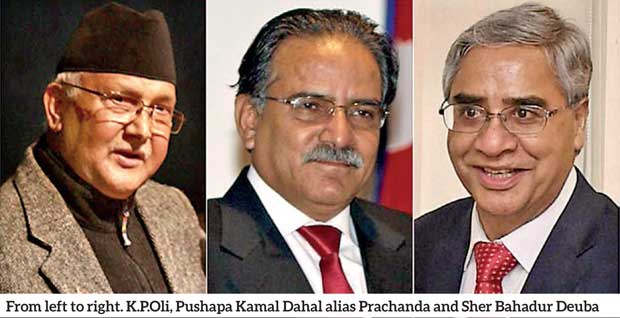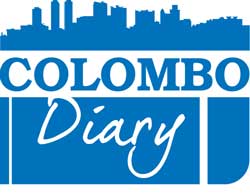Reply To:
Name - Reply Comment
Last Updated : 2024-04-26 02:12:00
A pro-China tilt is inevitable because both the CPN-UML and MC are avowedly pro-China
 Tentative results of the Nepalese Parliamentary elections suggest a massive victory for the Left Alliance comprising the Communist Party of Nepal (United Marxist Leninist) led by Khadga Prasad Oli, and the Communist Party of Nepal (Maoist Centre) led by Pushpa Kamal Dahal alias Prachanda.
Tentative results of the Nepalese Parliamentary elections suggest a massive victory for the Left Alliance comprising the Communist Party of Nepal (United Marxist Leninist) led by Khadga Prasad Oli, and the Communist Party of Nepal (Maoist Centre) led by Pushpa Kamal Dahal alias Prachanda.
The moderate Centre-Right Democratic Alliance led by Nepali Congress leader SherBahadurDeuba is likely to go out of office and sit in the Opposition benches.
The new Government, which will be formed in January 2018, has its tasks cut out. Both Oli and Prachanda have been Prime Ministers before. And Prachanda has been a Maoist rebel from 1996 to 2006, forcefully bringing to the fore the problems of the long-neglected Nepalese hoi polloi.
Therefore, the masses expect much from this Government.
On December 7, Nepal concluded the second and last phase of elections to the National Assembly, its Parliament.
Final results will not be out immediately, given requirements like apportioning seats under the Proportional Representation (PR) system, 33% reservation for women, and representation of minorities and marginalized communities like the Madhesis, Dalits, Janajatis and the Tharu.
However, as per the constitution, Parliament will have to be formed in January 2018.
In the first phase of the elections held on November 26, 37 seats were up for grabs under the First Past the Post System (FPP). In the second phase, held on December 7, 128 seats went to the polls under the FPP system.
The Nepalese Parliament has a total of 275 seats out of which 165 are filled through the FPP system and 110 by the PR system. The combined membership of the parliament elects the President and the Prime Minister by a simple majority.
The expected Leftist ‘victory’ is attributed to the Nepali Congress-led Government’s failure to give a strong and ideologically United Government to solve Nepal’ problems.
Nepal continues to be a very poor country. It is yet to recover from the devastating earthquake of 2015 in which 9,000 people were killed and thousands of houses were destroyed. Upto date, only 4% of the damaged houses have been repaired.
The Government and the political parties had been busy with political issues such as constitution making and resisting the demands of the Madhesi community for a greater political say. Local and provincial elections were also held, diverting the attention of the parties and the Government from economic development and earthquake relief.
Deuba and Prachanda were in alliance in the Government. But just before the first phase of the parliamentary elections in November, Prachanda broke away and joined K.P. Oli to fight the elections. Though the Maoist leader declared that he would continue to be with the Deuba Government till the elections, his action destabilized the regime politically.
Prachanda was Oli’s ideological comrade. He sensed that Nepal needed to attend to its grassroots level socio-economic problems, which were not being done by the Government under the leadership of Prime Minister Deuba.
Prachanda and Oli also felt the need to keep India in check as the latter has been supporting the Madhesi community comprising people of Indian origin living in the plains bordering India.
The Madhesis have been demanding the re-drawing of district boundaries to give them greater representation in elected bodies and reservations in Government jobs. Mainstream Nepalese political parties have been unable to accept these demands for fear of alienating the majority NepaleseIndia unofficially supported the forcible closure of the Nepal-India border by the agitating Madhesis.
This incurred the wrath of the majority community in Nepal and all the mainstream political parties. Both Oli and Prachandra felt that it was time Nepal counterbalanced India by seeking closer cooperation with China.

Main Electoral Issues
The majority of voters in Nepal have been yearning for a Government which will provide them jobs, health facilities, safe drinking water, education, and road networks. In the last three decades, the country has witnessed chronic political instability with 11 Prime Ministers in ten years.
The 10-year violent insurgency between 1996 and 2006 led by Prachanda had badly damaged the country’s economy. According to 2011 official figures, over two million Nepalese were working abroad as they were unable to find work at home.
Luckily this time, political parties are trying to attract voters through development agendas. People expect parties to eschew partisan politics and focus on development as there is no major political agenda for parties to deal with right now (except the one related to the Madhesis’ demands).
The Nepali Congress, the current ruling party, had promised to create 500,000 jobs within the next five years. The joint election manifesto of the Left Alliance, combining the CPN-UML and CPN (Maoist Centre), focused on stability, good governance, and economic prosperity. The Left Alliance had also said that under its rule, per capita income would reach $5,000 within five years. The alliance also pledged to create a massive increase in jobs for the youth.
Policies Toward China and India
A Leftist Nepalese Government is expected to be de-facto pro-China, though the official stance will be “equidistand” from India and China with an “independent” foreign political and economic policy.
A pro-China tilt is inevitable because both the CPN (UML) and CPN (MC) have been avowedly pro-China.
Given India’s inherited policy of controlling Nepalese politics, New Delhi is seen in Nepal as a partisan power. This has opened the door to the seemingly “non-partisan” China,which is desperate to encircle India.
When New Delhi messed up relations with Kathmandu by supporting the border blockade imposed by the Madhesis, China stepped up economic aid to Nepal. In 2016 Beijing pledged US$3.8 billion as against India’s commitment of US$317 million. Feasibility studies are underway for a China funded railway connecting Kathmandu to Lhasa in Tibet, cutting through the Himalayas at an estimated cost of US$8 billion.
China appears to be determined .. It has persuaded Nepal to join OBOR.. An editorial in China’s Global Times characterized the Sino-Indian competition as a “competition between the legacy of colonialism and Cold War logic, and the new global dynamics based on connectivity.”
The only saving grace for India has been Nepal’s neutrality during the tense India-China military standoff over Doklam on the Bhutan-China border.
But China appears to be determined to push the envelope in Nepal. It has persuaded Nepal to join the OBOR, a project India opposes tooth and nail.
An editorial in China’s State-run Global Times characterized the Sino-Indian competition to win the hand of Nepal as a “competition between the legacy of colonialism and Cold War logic, and the new global dynamics based on connectivity.”

As Narayani Basu says in The Diplomat, India cannot aspire to dole out the kind of aid that China is capable of handing out, but it can redeem its image by trying harder to get its economic projects in Nepal off the ground and being more circumspect and less partisan in its dealings with Nepal.
But no Government in Nepal can ignore India and go the whole hog with China, at least in the foreseeable future. Nepal is geographically placed in such a way that it can reach out to the world outside only through India. Economically it is inextricably tied to India both in terms of trade and employment. And then there is the Madhesi community there which will always look to India for support.

Add comment
Comments will be edited (grammar, spelling and slang) and authorized at the discretion of Daily Mirror online. The website also has the right not to publish selected comments.
Reply To:
Name - Reply Comment
US authorities are currently reviewing the manifest of every cargo aboard MV
On March 26, a couple arriving from Thailand was arrested with 88 live animal
According to villagers from Naula-Moragolla out of 105 families 80 can afford
Is the situation in Sri Lanka so grim that locals harbour hope that they coul